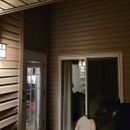Mini split on patio making patio hot…how hot is too hot for building materials?
I live in a condo. It gets obscenely hot so I got a mini split installed. We’re in the middle of a heat wave and I had to run the mini split at full power today.
The contractor (big hvac co) installed the heat pump outdoor unit in a way that maximizes space, so it follows all manufacturer clearance guidelines. My patio has a big overhang of about 15 feet tall that slopes down. So the mini split is installed underneath the underhang, about 8 inches from the wall on the left side and about 8 inches from the wall behind. In the front it’s got about 6 feet of clearance before it hits my living room door that goes out onto the patio.
So the unit itself gets HOT when it’s working hard to cool inside. The patio underhang becomes hot as hell when the mini split is at full tilt. When it’s a little bit hot out the unit blows out air that’s about 45 C (113 F). Today with the heat wave, I put a heat gun to the front of the heat pump outdoor unit and it registered 58 C (which is about 136 F) and the surrounding overhang and walls were about 125 F.
The patio is stone pavers and they get about 118 degrees at maximum during a heatwave, and the vinyl rainscreened cladding gets about 125 F from the heat pump blowing the hot air out.
Are these temperatures enough to damage surrounding material? My patio door, which is what the heat pump is mostly blowing on, is metal (aluminum) with a steel door handle which gets hot as well, and a piece of glass in the middle. No warping or anything.
More curious about if I am somehow damaging building materials with those temperatures.
To give an idea what it looks like, the covered BBQ on the right is approx where the outdoor unit is, blowing to the left towards the standard door
GBA Detail Library
A collection of one thousand construction details organized by climate and house part










Replies
The only materials you may hurt at all would be plastics, and even those usually need more heat than that to actually sustain damage. You could potentially see some minor softening though. Most plastics are rated to handle at least 60*C, many 90*C or more. Wood and especially metal will be fine, and won’t soften.
I would suggest possibly drying to divert the hot air away from your patio area for comfort though.
Bill
Thank you Bill for your reply! By plastics do you mean the vinyl siding? Unfortunately I can't get it to blow any other direction, as moving it towards the front of the patio would mean it would be so wide it would block my ability to get my grill around it to cook.
Interestingly, even though it blows hot air directly onto the door which is in my living room, absolutely no heat gets through the door and into the suite.
By "plastics", I mean any plastic building materials, which would include vinyl siding, PVC trim board, rubber weatherstripping, etc. Those are the materials most at risk from exposure to elevated temperatures over time. The only other thing that might show any issues would be paint.
If you can't move the unit, try making a baffle to divert the airflow. Metal sheet would be best for this, but you could also use plywood. Just be sure that if you try this, you construct the baffle in such a way that it diverts the flow, but does not restrict the flow, of the hot exhaust air. You also want to avoid recirculating the hot exhaust air back into the intake as much as possible.
Bill